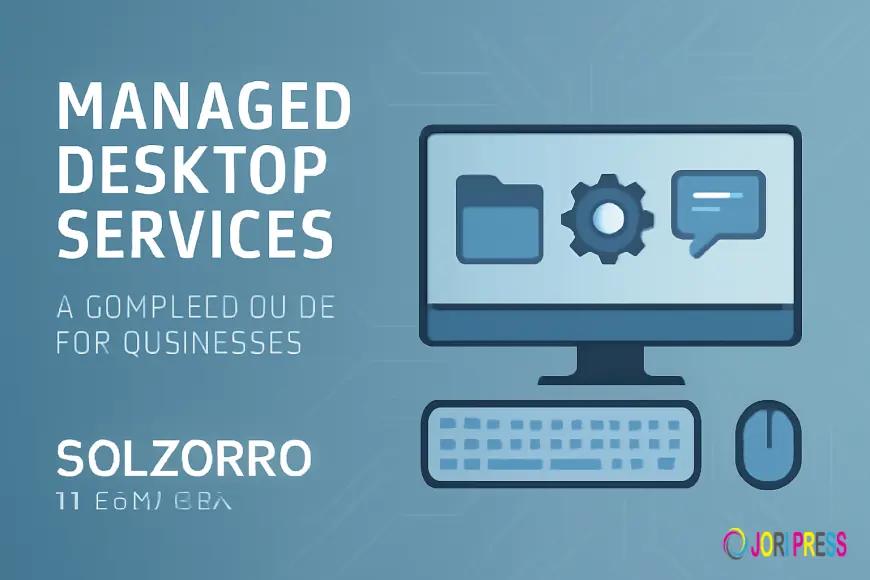Managed Desktop Services: A Complete Guide for Businesses
Discover outsourced IT support benefits for reducing downtime, boosting productivity, and keeping your business running smoothly with Solzorro.

Introduction
In today’s digital workplace, every employee relies on their desktop or laptop to perform essential tasks. But when systems are outdated, unpatched, or unsupported, productivity suffers. That’s where Managed Desktop Services come in. This approach allows businesses to streamline device management, strengthen security, and provide employees with reliable, always-ready workstations.
This guide explores what Managed Desktop Services are, their benefits, and why they’ve become a cornerstone of modern IT strategies.
What Are Managed Desktop Services?
Managed Desktop Services refer to the outsourcing of desktop management and support to an IT service provider. Instead of handling updates, troubleshooting, and lifecycle management internally, businesses partner with specialists who ensure desktops are secure, up-to-date, and optimized for performance.
Key elements typically include:
-
Device provisioning & setup – Ensuring employees receive configured, ready-to-use systems.
-
Patch management – Keeping operating systems and applications updated with the latest security patches.
-
Remote monitoring & support – Proactively detecting and resolving issues before they disrupt work.
-
Lifecycle management – Overseeing devices from deployment through replacement or upgrade.
-
Security & compliance – Applying policies to protect sensitive data and meet industry standards.
Why Businesses Choose Managed Desktop Services
1. Improved Productivity
Downtime is costly. With managed desktop services, proactive monitoring and timely updates prevent many issues before they affect employees. This ensures teams stay productive and minimize disruptions.
2. Enhanced Security
Cyber threats often target endpoint devices. Managed services help businesses stay ahead of risks with regular security patches, antivirus updates, and compliance-driven policies. According to Cybersecurity & Infrastructure Security Agency (CISA), outdated systems are among the top causes of breaches, making proactive management critical.
3. Predictable IT Costs
Rather than unexpected repair bills, businesses pay a flat monthly fee for consistent, reliable desktop support. This helps with budgeting and reduces the burden on internal IT teams.
4. Scalability for Growth
As companies grow, onboarding new employees and devices becomes easier. A managed service provider can quickly provision desktops with the right applications and security settings, ensuring smooth scaling.
The Value for Small and Mid-Sized Businesses
For smaller organizations without large IT departments, desktop management can be overwhelming. Managed Desktop Services provide enterprise-level support at an affordable cost, bridging the gap between internal limitations and modern IT demands.
This approach also frees up in-house IT staff to focus on higher-value projects rather than routine desktop troubleshooting.
How Managed Desktop Services Work
Step 1: Assessment
A provider begins by evaluating your existing infrastructure, security posture, and desktop management processes.
Step 2: Implementation
The provider deploys tools for remote monitoring, patch automation, and security enforcement. Devices are configured with company-specific policies.
Step 3: Ongoing Support
Employees gain access to a helpdesk for quick issue resolution. Automated updates keep devices current, while monitoring ensures early detection of problems.
Step 4: Reporting & Optimization
Regular reports highlight device health, patch status, and areas for improvement—allowing businesses to make informed IT decisions.
Choosing the Right Provider
When evaluating providers, businesses should consider:
-
Experience with compliance requirements (HIPAA, GDPR, etc.)
-
Service level agreements (SLAs) for guaranteed response times
-
Integration with existing IT infrastructure
-
Transparent pricing models
For example, at Solzorro, businesses can explore how Managed Desktop Services align with long-term IT strategies.
FAQs About Managed Desktop Services
Q1: What’s the difference between Managed Desktop Services and traditional IT support?
Traditional IT support often reacts to issues after they occur, while Managed Desktop Services focus on proactive management to prevent downtime and security risks.
Q2: Are Managed Desktop Services only for large enterprises?
No. Small and mid-sized businesses often benefit the most, since they gain enterprise-grade support without the overhead of maintaining a full internal IT team.
Q3: How do Managed Desktop Services improve security?
They enforce consistent patching, endpoint protection, and access policies—closing security gaps that cybercriminals often exploit.
Q4: What’s included in the monthly cost?
Services typically cover monitoring, patch management, troubleshooting, and support. The exact package depends on the provider’s offering and your business needs.
Final Thoughts
Managed Desktop Services are no longer a luxury—they’re a necessity for businesses that want to stay secure, productive, and competitive. By outsourcing desktop management, organizations reduce downtime, improve employee experience, and control IT costs with predictable pricing.
As the modern workplace becomes increasingly digital, businesses that adopt managed desktop solutions position themselves for smoother growth and stronger security.
Files
What's Your Reaction?
 Like
0
Like
0
 Dislike
0
Dislike
0
 Love
0
Love
0
 Funny
0
Funny
0
 Angry
0
Angry
0
 Sad
0
Sad
0
 Wow
0
Wow
0


















































